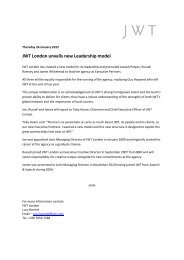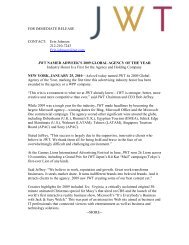the impending in-store marketing revolution - WPP.com
the impending in-store marketing revolution - WPP.com
the impending in-store marketing revolution - WPP.com
Create successful ePaper yourself
Turn your PDF publications into a flip-book with our unique Google optimized e-Paper software.
an update on groundbreak<strong>in</strong>gefforts to establish a universal<strong>in</strong>-<strong>store</strong> metricPG 2<strong>the</strong> media’s take on why so muchfocus is now be<strong>in</strong>g put on <strong>the</strong> <strong>store</strong>as media – and what it meansPG 10highlights from o<strong>the</strong>r articlesdetail<strong>in</strong>g profound changesaffect<strong>in</strong>g market<strong>in</strong>g at retailPG 14an <strong>in</strong>dustry on<strong>the</strong> vergeA new <strong>in</strong>itiative from Nielsen and <strong>the</strong> In-Store Market<strong>in</strong>gInstitute moves retail closer to a measured mediumBY PETER BREEN, IN-STORE MARKETING INSTITUTECHICAGO — Data collected through <strong>the</strong>P.R.I.S.M. project may quite literally transform<strong>the</strong> retail environment, and should have amajor impact on <strong>the</strong> future of market<strong>in</strong>g toconsumers.The Pioneer<strong>in</strong>g Research for an In-StoreMetric project has achieved its primaryobjective to measure retail traffic at <strong>the</strong>category level. Under <strong>the</strong> direction ofThe Nielsen Company, <strong>the</strong> <strong>in</strong>itiative nowhas moved beyond traffic counts by<strong>in</strong>corporat<strong>in</strong>g <strong>store</strong> <strong>com</strong>munication auditsto derive estimates for consumer reach.In o<strong>the</strong>r words, <strong>the</strong> <strong>in</strong>-<strong>store</strong> “audience” formarket<strong>in</strong>g <strong>com</strong>munications can now bequantified, which makes retail a measuredmedium similar to TV, radio, pr<strong>in</strong>t and onl<strong>in</strong>e.“This metric will allow everyone ga<strong>the</strong>red <strong>in</strong>this room to truly beg<strong>in</strong> to treat and discuss<strong>the</strong> physical <strong>store</strong> as a market<strong>in</strong>g medium,”David Calhoun, The Nielsen Company’schief executive officer, told an audience ofmore than 1,000 ga<strong>the</strong>red for a special paneldiscussion on P.R.I.S.M. at <strong>the</strong> In-StoreMarket<strong>in</strong>g Expo <strong>in</strong> Chicago on Sept. 27.“We’ve <strong>com</strong>e an enormous distance <strong>in</strong> an<strong>in</strong>credibly short period of time,” said PeterHoyt, executive director of <strong>the</strong> In-StoreMarket<strong>in</strong>g Institute, which spearheaded<strong>the</strong> first stage of <strong>the</strong> P.R.I.S.M. project withsupport from a consortium of consumerproduct manufacturers and retailers.Inability to measure <strong>the</strong> audience for <strong>in</strong>-<strong>store</strong>market<strong>in</strong>g activity has long been a stumbl<strong>in</strong>gblock to treat<strong>in</strong>g retail as a viable medium forbrand-build<strong>in</strong>g consumer <strong>com</strong>munication.2Published October 1, 2007
This obstacle has now been removed,members of <strong>the</strong> panel discussion said.“Because we are gett<strong>in</strong>g a better readon how <strong>in</strong>-<strong>store</strong> messag<strong>in</strong>g impactsconsumers, we can create more effectiveways to engage <strong>the</strong>m <strong>in</strong> <strong>the</strong> shopp<strong>in</strong>genvironment,” said Renetta McCann,chief executive officer of Star<strong>com</strong>MediaVest Group. “This elevates <strong>the</strong> <strong>store</strong>to <strong>the</strong> status of new media, as critical assearch or mobile or gam<strong>in</strong>g <strong>in</strong> <strong>the</strong> overallmarket<strong>in</strong>g mix.”But <strong>the</strong> P.R.I.S.M. project’s impact on <strong>the</strong>retail marketplace goes much deeper,accord<strong>in</strong>g to panel members, because <strong>the</strong>data unlocks a wealth of <strong>in</strong>formation thatcan be used to transform <strong>the</strong> way retailersand consumer product manufacturersmerchandise products and <strong>com</strong>municatewith shoppers.“P.R.I.S.M. can dramatically change<strong>the</strong> way we as retailers create a more<strong>com</strong>pell<strong>in</strong>g <strong>in</strong>-<strong>store</strong> environment byhelp<strong>in</strong>g us to truly anticipate <strong>the</strong> needs ofour customer,” expla<strong>in</strong>ed Steve Bratspies,senior vice president of market<strong>in</strong>gfor Wal-Mart Stores Inc. “We’ll beg<strong>in</strong>design<strong>in</strong>g <strong>store</strong>s that are more <strong>in</strong>tuitivefor our shoppers. Stores that are easier tonavigate. Stores with products displayed<strong>in</strong> a customer-friendly manner. Ultimately,we’ll be able to deliver <strong>the</strong> <strong>in</strong>formationthat customers need to make <strong>the</strong> bestpurchase decisions and make <strong>the</strong> <strong>in</strong>-<strong>store</strong>experience one of <strong>the</strong> most powerfulmarket<strong>in</strong>g media.”“With P.R.I.S.M., we are go<strong>in</strong>g to be ableto measure reach by category, by retailer,”said Bob McDonald, chief operat<strong>in</strong>g officerof Procter & Gamble. “By tak<strong>in</strong>g this data[and] align<strong>in</strong>g it aga<strong>in</strong>st <strong>the</strong> cost of specificphysical <strong>in</strong>-<strong>store</strong> executions, we are go<strong>in</strong>gto be able to establish CPM — <strong>the</strong> costper thousand to reach those shoppers<strong>in</strong> a particular category and by <strong>store</strong>.This will lay <strong>the</strong> foundations for preciselymeasur<strong>in</strong>g return on <strong>in</strong>vestment for specificexecutions or displays by category, byretailer. You are even go<strong>in</strong>g to be able toestablish ROI by geography – what worksbetter <strong>in</strong> Florida than <strong>in</strong> Ill<strong>in</strong>ois – or evenROI by seasonality.”INITIAL FINDINGS FROM P.R.I.S.M.Data collected by Nielsen In-Store dur<strong>in</strong>g<strong>the</strong> second phase of field researchconducted this summer quantifies somefacts that marketers have believed –anecdotally, at least – for several years.“The retail audience is enormous,” saidCalhoun. “It is <strong>the</strong> largest audienceavailable today. Right now millions ofshoppers are <strong>in</strong>-<strong>store</strong>. But P.R.I.S.M. letsus know about more than just <strong>the</strong> totalaudience size for a retailer. It tells uswhere <strong>in</strong> <strong>the</strong> <strong>store</strong> <strong>the</strong> shoppers are andhow that changes by time of day and dayof week.”“In some food <strong>store</strong>s, <strong>the</strong> heaviest trafficflow is not through <strong>the</strong> carbonatedbeverage and snack aisles – which mightbe <strong>the</strong> conventional wisdom based onsales rates – but through <strong>the</strong> yogurt andeggs section of <strong>the</strong> <strong>store</strong>.”“Wal-Mart’s footpr<strong>in</strong>t across NorthAmerica is dramatic. Every day, morethan 20 million customers walkthrough our doors.”—Steve Bratspies, SVP Market<strong>in</strong>g,Wal-Mart“As a result, our <strong>store</strong>s are an <strong>in</strong>crediblypowerful media vehicle,” said Bratspiesdur<strong>in</strong>g his presentation. “But <strong>in</strong> reality,<strong>the</strong> <strong>store</strong> itself has never been trulyconsidered and leveraged among <strong>the</strong>ranks of <strong>the</strong> top market<strong>in</strong>g and mediatools, even though its potential reach andeffectiveness equal if not surpass o<strong>the</strong>rtraditional media vehicles.”Secondly, <strong>the</strong>re are significant numbers ofshoppers who browse aisles but don’t buyanyth<strong>in</strong>g. “Until now, we have known a lotabout <strong>the</strong> people who made purchases,”said Calhoun. “However, now we haveCont<strong>in</strong>ued on next page3
Watch<strong>in</strong>g as You ShopRetail<strong>in</strong>g: Big shops are us<strong>in</strong>g elaborate technology tomonitor and <strong>in</strong>fluence <strong>the</strong> behaviour of <strong>the</strong>ir customersLONDON — In a recent British television <strong>com</strong>mercial, John McEnroe, aveteran tennis star, is seen rac<strong>in</strong>g his long-time rival Bjorn Borg arounda Tesco supermarket. After arriv<strong>in</strong>g <strong>in</strong> <strong>the</strong> checkout queue just ahead ofhis opponent, Mr. McEnroe is distraught to see an employee appear andopen ano<strong>the</strong>r till, giv<strong>in</strong>g Mr. Borg <strong>the</strong> upper hand. The advertisment endswith a reference to Tesco’s “one <strong>in</strong> front” <strong>in</strong>itiative, which aims to reducewait<strong>in</strong>g times by open<strong>in</strong>g additional tills whenever <strong>the</strong>re is more than onecustomer wait<strong>in</strong>g at a checkout. This scheme has been runn<strong>in</strong>g for manyyears, but Tesco recently updated it by <strong>in</strong>vest<strong>in</strong>g <strong>in</strong> customer-monitor<strong>in</strong>gtechnology supplied by Irisys, a British <strong>com</strong>pany.The system, called Smartlane, has two elements: sensors by <strong>the</strong> doorscount <strong>the</strong> number of people enter<strong>in</strong>g and leav<strong>in</strong>g <strong>the</strong> shop, and sensorsby <strong>the</strong> tills work out how fast <strong>the</strong> queues are mov<strong>in</strong>g and how many“shopp<strong>in</strong>g units” — groups of people, such as families or couples, whowill make one transaction between <strong>the</strong>m — are stand<strong>in</strong>g <strong>in</strong> each queue.(Shopp<strong>in</strong>g units are identified us<strong>in</strong>g an <strong>in</strong>fra-red sensor that tracks <strong>the</strong>trajectory and behaviour of “hot blobs” when <strong>the</strong>y enter its field of vision;this approach is 95% accurate, says Chris Precious of Irisys.) All this<strong>in</strong>formation can <strong>the</strong>n be used to predict how many tills will be neededup to an hour <strong>in</strong> advance and monitor average wait<strong>in</strong>g times and queuelengths. In Tesco’s case, a l<strong>in</strong>e longer than one shopp<strong>in</strong>g unit triggers<strong>the</strong> open<strong>in</strong>g of ano<strong>the</strong>r till. Sir Terry Leahy, Tesco’s boss, said last yearthat <strong>the</strong> monitor<strong>in</strong>g system had reduced wait<strong>in</strong>g time for customers andhelped to boost <strong>the</strong> firm’s profits.Tesco is not <strong>the</strong> only retailer us<strong>in</strong>g technology to keep tabs on people<strong>in</strong> its <strong>store</strong>s. Mr. Precious says Price Chopper, an American grocerycha<strong>in</strong>, is <strong>in</strong> <strong>the</strong> process of <strong>in</strong>troduc<strong>in</strong>g Smartlane; and Marks & Spencer,a British shopp<strong>in</strong>g cha<strong>in</strong>, uses Irisys’s <strong>in</strong>fra-red sensors, as doesAbercrombie & Fitch, an American fashion cha<strong>in</strong>. Brickstream, a supplierof customer-monitor<strong>in</strong>g systems based on dual-lens cameras, whichare more accurate than s<strong>in</strong>gle-lens cameras <strong>in</strong> track<strong>in</strong>g and count<strong>in</strong>gapplications, counts big retail cha<strong>in</strong>s <strong>in</strong>clud<strong>in</strong>g Toys “R” Us, Office Depotand Walgreens among its clients.Ra<strong>the</strong>r than monitor<strong>in</strong>g queue lengths, however, Brickstream’s system,called BehaviorIQ, is used by retailers to ga<strong>the</strong>r data on where <strong>the</strong>irPublished December 6, 2007customers go, where and how long <strong>the</strong>y stop, and how <strong>the</strong>y react todifferent products. This <strong>in</strong>formation can <strong>the</strong>n be <strong>com</strong>pared with <strong>the</strong><strong>store</strong>’s transaction log to determ<strong>in</strong>e <strong>the</strong> effectiveness of <strong>store</strong> layout,product fixtures and o<strong>the</strong>r variables. In-<strong>store</strong> designs and market<strong>in</strong>gcampaigns that work can be identified and improved upon, and thosethat do not can be replaced with someth<strong>in</strong>g more profitable. Retailers,it seems, are buy<strong>in</strong>g <strong>the</strong> idea that by watch<strong>in</strong>g customers while <strong>the</strong>yshop — what might be called “retail surveillance” — and redesign<strong>in</strong>g<strong>the</strong>ir shops accord<strong>in</strong>gly, <strong>the</strong>y can get people to spend more.ON THE SHOP FLOOROne of <strong>the</strong> largest customer-monitor<strong>in</strong>g projects undertaken so far isP.R.I.S.M. (or “Pioneer<strong>in</strong>g Research for an In-Store Metric”), a collaborationbetween Nielsen Media, a market-research firm, <strong>the</strong> In-<strong>store</strong> Market<strong>in</strong>gInstitute, based <strong>in</strong> Chicago, and a consortium of consumer-goodsmanufacturers and retailers <strong>in</strong>clud<strong>in</strong>g Coca-Cola, Procter & Gamble andWal-Mart. The project, which <strong>com</strong>pleted its first big trial <strong>in</strong> September,<strong>in</strong>volved <strong>the</strong> use of sensors at <strong>the</strong> entrance and exits and <strong>in</strong> some of<strong>the</strong> aisles of 160 <strong>store</strong>s across America. These sensors recorded dataon customer-traffic patterns, to which was added fur<strong>the</strong>r <strong>in</strong>formationrecorded by human observers. By <strong>com</strong>par<strong>in</strong>g <strong>the</strong> result<strong>in</strong>g data withsales <strong>in</strong>formation, it was <strong>the</strong>n possible to ga<strong>in</strong> <strong>in</strong>sight <strong>in</strong>to shoppers’behaviour.Prelim<strong>in</strong>ary results from <strong>the</strong> P.R.I.S.M. programme <strong>in</strong>cluded <strong>the</strong> f<strong>in</strong>d<strong>in</strong>gthat two-thirds of shoppers who made a visit to <strong>the</strong> salty-snacks aislemade a purchase, but <strong>the</strong> people visit<strong>in</strong>g <strong>the</strong> dairy aisle were far less likelyto buy someth<strong>in</strong>g. When observational data on <strong>the</strong> number of childrenpresent dur<strong>in</strong>g a shopp<strong>in</strong>g trip was taken <strong>in</strong>to account, <strong>the</strong> results wereeven more detailed: <strong>the</strong> P.R.I.S.M. results showed that although childrentook part <strong>in</strong> only 13% of food-shopp<strong>in</strong>g trips, shoppers bought morewhen children were with <strong>the</strong>m. Purchase of seasonal items was two anda half times more likely with children <strong>in</strong> tow, but surpris<strong>in</strong>gly <strong>the</strong>re was nocorrelation found between <strong>the</strong> presence of children on a shopp<strong>in</strong>g tripand higher spend<strong>in</strong>g on sweets.Cont<strong>in</strong>ued on next page5
Cont<strong>in</strong>ued from page 5With this k<strong>in</strong>d of f<strong>in</strong>e-gra<strong>in</strong>ed data, says George Wishart, <strong>the</strong> head ofNielsen’s <strong>in</strong>-<strong>store</strong> division, retailers can adjust <strong>store</strong> layouts and staff<strong>in</strong>glevels accord<strong>in</strong>gly. Although retailers th<strong>in</strong>k <strong>the</strong>y know how to positionproducts <strong>in</strong> a way that will maximise sales, says Peter Hoyt of <strong>the</strong>In-<strong>store</strong> Market<strong>in</strong>g Institute, “<strong>the</strong> science of adjacency is not a science.”With P.R.I.S.M., he says, <strong>the</strong> gut feel<strong>in</strong>g that peanut butter should beplaced on a shelf next to jam <strong>in</strong> order to <strong>in</strong>crease <strong>the</strong> likelihood of a<strong>com</strong>b<strong>in</strong>ation purchase can be tested directly aga<strong>in</strong>st sales data.“Shoppers are not just be<strong>in</strong>g monitored by cameras andsensors — sometimes speech is recorded, too.”Best Buy, a big American consumer-electronics cha<strong>in</strong>, takes this astep fur<strong>the</strong>r. It uses Brickstream’s BehaviorIQ cameras to collect dataon its customers’ behaviour patterns and has used this <strong>in</strong>formation todivide <strong>the</strong>m <strong>in</strong>to five customer types — young technology enthusiasts,suburban mo<strong>the</strong>rs, affluent early adopters, family men and smallbus<strong>in</strong>essowners — who want different th<strong>in</strong>gs. Each group is <strong>the</strong>nprovided with an area of <strong>the</strong> shop designed to meet <strong>the</strong>ir needs.As <strong>the</strong> technology improves, it is gett<strong>in</strong>g easier for o<strong>the</strong>r retailers todo <strong>the</strong> same sort of th<strong>in</strong>g. VideoM<strong>in</strong><strong>in</strong>g, for example, a sp<strong>in</strong>-out fromPennsylvania State University, uses a <strong>com</strong>b<strong>in</strong>ation of video camerasand software to capture and analyse thousands of hours of footage ofcustomer behaviour. As well as provid<strong>in</strong>g <strong>in</strong>formation about customerbehaviour, <strong>the</strong> firm’s software can also determ<strong>in</strong>e each shopper’s sex,age range and ethnic group with an accuracy of around 80%, says JeffHershey of VideoM<strong>in</strong><strong>in</strong>g. The result is an “activity map” which can helpretailers to identify <strong>the</strong> factors that drive higher sales. The system can evenbe programmed to detect <strong>the</strong> characteristic behaviour of shoplifters.Inevitably, all this raises concerns about privacy. Count<strong>in</strong>g customerswith motion sensors as <strong>the</strong>y enter a supermarket is one th<strong>in</strong>g, butsort<strong>in</strong>g <strong>the</strong>m <strong>in</strong>to social or racial groups us<strong>in</strong>g video analysis is ano<strong>the</strong>r.Mr. Hershey responds that none of <strong>the</strong> footage or <strong>in</strong>formation about<strong>in</strong>dividual shoppers is <strong>store</strong>d. Besides, says John Green<strong>in</strong>g of <strong>the</strong>Medill School at Northwestern University, customers are generallywill<strong>in</strong>g to give up some personal <strong>in</strong>formation if <strong>the</strong>y feel <strong>the</strong>y are gett<strong>in</strong>gsome benefit <strong>in</strong> return. Ra<strong>the</strong>r than see<strong>in</strong>g customer monitor<strong>in</strong>g as an<strong>in</strong>vasion of privacy, he considers it a means of mak<strong>in</strong>g shopp<strong>in</strong>g a morepleasant experience for “time-<strong>com</strong>pressed” (i.e., busy) consumers.These systems, he says, are “not a matter of Big Bro<strong>the</strong>r,” but ra<strong>the</strong>r ameans of ga<strong>in</strong><strong>in</strong>g <strong>in</strong>sight and “understand<strong>in</strong>g motives.”LISTENING INShoppers are not just be<strong>in</strong>g monitored by cameras and heat sensors,however; sometimes <strong>the</strong>ir speech is be<strong>in</strong>g recorded, too. Recordant, an<strong>in</strong>-<strong>store</strong> monitor<strong>in</strong>g <strong>com</strong>pany based <strong>in</strong> Atlanta, provides shop assistantswith digital-audio recorders, to be worn around <strong>the</strong>ir necks, whichrecord all <strong>the</strong>ir conversations with shoppers. At <strong>the</strong> end of each day <strong>the</strong>record<strong>in</strong>g devices are plugged <strong>in</strong>to special dock<strong>in</strong>g stations and <strong>the</strong>record<strong>in</strong>gs are uploaded to Recordant’s headquarters for analysis. Itssoftware trawls <strong>the</strong> recorded dialogue for particular words or phraseswithout <strong>the</strong> need for any human <strong>in</strong>put <strong>in</strong> order to provide accurate<strong>in</strong>formation on employee performance and customer behaviour.BRICKSTREAM MAPS A SUPERMARKET’S HOT SPOTSRecordant says that trials <strong>in</strong> 40 locations have proved <strong>the</strong> value of <strong>the</strong>technology: one retailer was able to show that <strong>the</strong>re was a 300% <strong>in</strong>crease<strong>in</strong> sales of products re<strong>com</strong>mended by shop assistants to customers.By provid<strong>in</strong>g precise measurements of this k<strong>in</strong>d, <strong>the</strong> technology allowsretailers to ref<strong>in</strong>e <strong>the</strong>ir tra<strong>in</strong><strong>in</strong>g programmes and evaluate <strong>the</strong> effectivenessof promotions. They can even collect “<strong>com</strong>petitive <strong>in</strong>telligence” byprogramm<strong>in</strong>g <strong>the</strong> system to search for <strong>the</strong> names of rival retailers, saysChris Etter, <strong>the</strong> chief executive of Recordant.Unlike systems based on video cameras or sensors, Recordant’stechnology is required to notify customers explicitly that <strong>the</strong>irconversations are be<strong>in</strong>g recorded. To this end, <strong>the</strong> record<strong>in</strong>g devices<strong>in</strong>clude a small video screen which displays a message <strong>in</strong>form<strong>in</strong>gshoppers what is go<strong>in</strong>g on. Mr. Etter admits that both employees andcustomers have expressed worries about privacy and have shown someresistance to <strong>the</strong> devices. But he likens this to <strong>the</strong> <strong>in</strong>itial disquiet over <strong>the</strong>record<strong>in</strong>g of customer-service telephone calls, someth<strong>in</strong>g that is nowwidely accepted. Besides, he says, <strong>the</strong> system can provide protectionfor employees who get <strong>in</strong>volved <strong>in</strong> disputes with fractious customers.As useful as customer-track<strong>in</strong>g systems may be for exonerat<strong>in</strong>gharassed staff or m<strong>in</strong>imis<strong>in</strong>g shoplift<strong>in</strong>g, however, <strong>the</strong>ir primary objectivesare clear. In an age when traditional “bricks and mortar” retailers facestiff <strong>com</strong>petition from onl<strong>in</strong>e merchants, any means <strong>the</strong>y can use to getcustomers <strong>in</strong>to <strong>the</strong>ir shops and buy<strong>in</strong>g as much as possible is seen asa worthwhile <strong>in</strong>vestment. Long before <strong>the</strong> advent of e-<strong>com</strong>merce, Wal-Mart’s founder Sam Walton set out his vision for a successful retailoperation: “We let folks know we’re <strong>in</strong>terested <strong>in</strong> <strong>the</strong>m and that <strong>the</strong>y’revital to us — ’cause <strong>the</strong>y are,” he said. Customer-monitor<strong>in</strong>g systems areunderl<strong>in</strong><strong>in</strong>g just how <strong>in</strong>terested, and just how vital.6© Copyright © 2007 The Economist Newspaper and The Economist Group. All rights reserved.
Alive onArrival Published<strong>in</strong> Nov./Dec. 2007BY CHRIS HOYT, HOYT & CO.SCOTTSDALE, ARIZ. — In its October 1st edition, Advertis<strong>in</strong>g Age— that bastion of th<strong>in</strong>kers that has long held that retail is “tactical”and <strong>the</strong>refore awfully pedestrian — actually published an article onshopper market<strong>in</strong>g on <strong>the</strong> front page. The article acknowledged — <strong>in</strong>so many words — that retail may now be emerg<strong>in</strong>g as a new, legitimatebattleground for build<strong>in</strong>g share, extend<strong>in</strong>g equity and <strong>in</strong>creas<strong>in</strong>gloyalty. This breakthrough, if we <strong>in</strong>terpret this article correctly, may beattributed to three th<strong>in</strong>gs.First, <strong>the</strong> P.R.I.S.M. <strong>in</strong>itiative promises a standardized, syndicatedmeasurement model to evaluate <strong>in</strong>-<strong>store</strong> consumer reach, <strong>the</strong>rebyenabl<strong>in</strong>g advertisers to benchmark <strong>the</strong>se results aga<strong>in</strong>st moretraditional forms of advertis<strong>in</strong>g and <strong>com</strong>munications <strong>in</strong>vestments.Second, <strong>the</strong> l<strong>in</strong>e-up of <strong>com</strong>panies support<strong>in</strong>g <strong>the</strong> P.R.I.S.M. <strong>in</strong>itiativevirtually guarantees <strong>in</strong>dustry-wide acceptance (assum<strong>in</strong>g <strong>the</strong> resultsare verifiable). These not only <strong>in</strong>clude many of <strong>the</strong> top players <strong>in</strong> <strong>the</strong>CPG <strong>in</strong>dustry today (Nielsen, P&G, ConAgra, Campbell’s, etc.) but —significantly — no fewer than six top advertis<strong>in</strong>g agencies.As Renatta McCann, CEO of Star<strong>com</strong> MediaVest Group North America,declared: “Shopper market<strong>in</strong>g is a new medium as important as <strong>the</strong><strong>in</strong>ternet, mobile or gam<strong>in</strong>g.” That’s quite a statement from a segmentof <strong>the</strong> <strong>in</strong>dustry that formerly viewed retail as virtually <strong>in</strong>visible.F<strong>in</strong>ally, <strong>the</strong> leadership of Procter & Gamble — <strong>the</strong> <strong>com</strong>pany that startedit all — and <strong>the</strong> <strong>com</strong>pany that is <strong>in</strong> so many product categories, isforc<strong>in</strong>g its <strong>com</strong>petitors to get good at shopper market<strong>in</strong>g just to stayeven. To satisfy Wall Street analysts who thought P&G was graduallywhittl<strong>in</strong>g down its traditional advertis<strong>in</strong>g expenditures, <strong>the</strong> <strong>com</strong>panyannounced <strong>in</strong> September that it would now treat <strong>in</strong>-<strong>store</strong> market<strong>in</strong>gexpenditures as traditional advertis<strong>in</strong>g expenditures and, to that end,restated 11 years of advertis<strong>in</strong>g <strong>in</strong>vestments.Based on this, <strong>the</strong> <strong>in</strong>dications are that P&G is currently spend<strong>in</strong>gapproximately $500MM per year on its shopper market<strong>in</strong>g <strong>in</strong>itiatives— an <strong>in</strong>vestment we know <strong>the</strong> ROI-based <strong>com</strong>pany would not makeunless <strong>the</strong> results were better than traditional alternatives.The bottom l<strong>in</strong>e, as Advertis<strong>in</strong>g Age po<strong>in</strong>ts out, is that shoppermarket<strong>in</strong>g is now grow<strong>in</strong>g faster than <strong>in</strong>ternet advertis<strong>in</strong>g, doubl<strong>in</strong>gs<strong>in</strong>ce 2004 and on a pace for a <strong>com</strong>pound annual growth rate of awhopp<strong>in</strong>g 21 percent through 2010.This simply confirms a Reveries.<strong>com</strong> f<strong>in</strong>d<strong>in</strong>g <strong>in</strong> one of <strong>the</strong> surveysit did on this subject last spr<strong>in</strong>g, <strong>in</strong> which 84 % of 167 respond<strong>in</strong>g<strong>com</strong>panies reported that <strong>the</strong>y expected <strong>the</strong>ir shopper market<strong>in</strong>gbudgets to <strong>in</strong>crease over <strong>the</strong> next three years — a remarkably highand unusual number.STAKEHOLDERS ALIGNFor once, all key stakeholders have a vested <strong>in</strong>terest <strong>in</strong> mak<strong>in</strong>g itsuccessful for each o<strong>the</strong>r. Retailers view shopper market<strong>in</strong>g as <strong>the</strong>means by which <strong>the</strong>y can <strong>in</strong>crease customer loyalty through relevancyand <strong>the</strong>refore <strong>the</strong> mechanism by which <strong>the</strong>y can differentiate <strong>in</strong>mean<strong>in</strong>gful ways on a non-price basis. This is clearly work<strong>in</strong>g for<strong>com</strong>panies like Safeway, Kroger and Best Buy.Manufacturers view shopper market<strong>in</strong>g as a clear way to establish amean<strong>in</strong>gful <strong>com</strong>petitive edge — more specifically, as an opportunityfor significantly better target<strong>in</strong>g of <strong>the</strong> shopper <strong>in</strong> an environmentwhere <strong>the</strong>y know <strong>the</strong>y will be able to reach (or “touch”) 100 percent of<strong>the</strong>ir target consumers at least 2-3 times per month (or more!) everymonth of <strong>the</strong> year.In addition, shopper market<strong>in</strong>g offers suppliers <strong>the</strong> basis for truecollaboration with retailers on levels previously unheard of, as bothwork toge<strong>the</strong>r to identify, segment and activate <strong>the</strong> shopper. With <strong>the</strong>advent of P.R.I.S.M., advertis<strong>in</strong>g agencies can no longer afford to turnup <strong>the</strong>ir noses at retail as manufacturers beg<strong>in</strong> to use P.R.I.S.M. resultsto reallocate market<strong>in</strong>g spend<strong>in</strong>g <strong>in</strong>to those media that deliver <strong>the</strong>highest ROI — and now this will <strong>in</strong>clude retail. Those <strong>in</strong> <strong>the</strong> forefrontof this, like Star<strong>com</strong> MediaVest, will clearly prosper as manufacturersstart to seek out agencies that have made it a priority to be<strong>com</strong>e “bestpractitioners” with respect to retail advertis<strong>in</strong>g and <strong>com</strong>munications.Cont<strong>in</strong>ued on next page7
What’s In Store: The Riseof Shopper Market<strong>in</strong>gBY JACK NEFF, ADVERTISING AGEP&G, Wal-Mart, Nielsen Dive Into MediumThat’s Grow<strong>in</strong>g Faster Than WebCHICAGO — So this is what market<strong>in</strong>g has <strong>com</strong>eto: The hottest medium around may be pastedto <strong>the</strong> floor at Wal-Mart or dangl<strong>in</strong>g from a shelfon aisle five at Safeway, segmented <strong>in</strong>to suchdayparts as “national weekday cereal aisle.”Laugh if you want, but some people believeshopper market<strong>in</strong>g will reshape market<strong>in</strong>g forsome very big spenders. Senior executives from<strong>the</strong> world’s biggest advertiser, biggest retailerand biggest media-buy<strong>in</strong>g agency turned upat <strong>the</strong> In-Store Market<strong>in</strong>g Expo <strong>in</strong> Chicago lastweek to tout a new way of measur<strong>in</strong>g shoppermarket<strong>in</strong>g by <strong>the</strong> world’s biggest research firm,Nielsen Co.10It was just one more milestone for shoppermarket<strong>in</strong>g, which is grow<strong>in</strong>g faster than Internetadvertis<strong>in</strong>g — doubl<strong>in</strong>g s<strong>in</strong>ce 2004 and on pace fora <strong>com</strong>pound annual growth rate of 21% through2010, accord<strong>in</strong>g to a draft study by Deloitte from<strong>the</strong> Grocery Manufacturers Association.“Shopper market<strong>in</strong>g is a new medium as importantas <strong>the</strong> Internet, mobile or gam<strong>in</strong>g,” declaredStar<strong>com</strong> MediaVest Group North America CEORenetta McCann at <strong>the</strong> announcement of pilotresults us<strong>in</strong>g Nielsen In-Store’s P.R.I.S.M.<strong>in</strong>itiative, essentially a rat<strong>in</strong>gs system for <strong>in</strong><strong>store</strong>media and market<strong>in</strong>g that measures reachand frequency similar to TV. “It’s a brand-newballgame, and we’re all <strong>in</strong>.”P&G steps up spend<strong>in</strong>gLate last month, <strong>the</strong> world’s largest advertiser,Procter & Gamble Co., restated 11 years ofadvertis<strong>in</strong>g expenditures <strong>in</strong> its f<strong>in</strong>ancial reports,largely to reflect spend<strong>in</strong>g on shopper market<strong>in</strong>g.The mov<strong>in</strong>g parts <strong>in</strong> <strong>the</strong> restatement suggestP&G is spend<strong>in</strong>g at least $500 million annuallyon shopper market<strong>in</strong>g. And <strong>the</strong> Deloitte/GMAdata suggest <strong>the</strong> marketer may actually be abit beh<strong>in</strong>d o<strong>the</strong>rs <strong>in</strong> <strong>the</strong> <strong>in</strong>dustry <strong>in</strong> share ofmarket<strong>in</strong>g spend<strong>in</strong>g <strong>the</strong>re. P&G also recentlymoved many of its shopper-market<strong>in</strong>g executivesto <strong>the</strong> same brand teams that determ<strong>in</strong>e <strong>the</strong> restof its $8 billion <strong>in</strong> global ad spend<strong>in</strong>g. Nowhere,however, was <strong>the</strong> dissonance between shopperm a r k e t i n g ’s g ro w i n g i m p o r t a n c e a n d i t s o f t e nlowly appearance more apparent than at <strong>the</strong> In-Store Market<strong>in</strong>g Expo. As some of <strong>the</strong> top names<strong>in</strong> market<strong>in</strong>g talked <strong>the</strong>ory <strong>in</strong> <strong>the</strong> auditorium, <strong>the</strong>practice of shopper market<strong>in</strong>g was <strong>in</strong> full display<strong>in</strong> <strong>the</strong> adjacent convention hall, where <strong>the</strong> latestvendors of video-enhanced shopp<strong>in</strong>g carts viedfor attention alongside makers of corrugateddisplays.This brave new world means buyers need toknow not just how to bet <strong>in</strong> May on rat<strong>in</strong>gs forfall shows but also how to hedge <strong>the</strong> price ofcorrugated paper for end-aisle displays or hagglewith News Corp. over someth<strong>in</strong>g called “shelftalkers.”It wasn’t so long ago that media agenciesweren’t <strong>in</strong> <strong>the</strong> game at all, said Peter Hoyt,executive director of <strong>the</strong> In-Store Market<strong>in</strong>gInstitute. Now he knows every time a bigmedia review is under way, he said, because
“Shopper market<strong>in</strong>g is a new medium asimportant as <strong>the</strong> Internet, mobile or gam<strong>in</strong>g,”declared Star<strong>com</strong> MediaVest GroupNorth America CEO Renetta McCann.“It’s a brand-new ballgame, and we’re all <strong>in</strong>.”Published on October 1, 2007<strong>the</strong> <strong>in</strong>stitute starts gett<strong>in</strong>g hits on its website from media agencies— and new members, s<strong>in</strong>ce much of <strong>the</strong> data <strong>the</strong>re is for membersonly.Large stakesFollow<strong>in</strong>g SMG’s <strong>in</strong>itial <strong>in</strong>volvement <strong>in</strong> <strong>the</strong> Nielsen/P.R.I.S.M.<strong>in</strong>itiative, five media agencies have jo<strong>in</strong>ed <strong>the</strong> consortium beh<strong>in</strong>d<strong>the</strong> effort, said George Wishart, global manag<strong>in</strong>g director ofNielsen In-Store. The agencies are follow<strong>in</strong>g <strong>the</strong> media <strong>com</strong>panies;<strong>the</strong> parents of <strong>the</strong> four lead<strong>in</strong>g broadcast networks have a stake <strong>in</strong>some facet of <strong>in</strong>-<strong>store</strong> media.So Nielsen needs to get <strong>in</strong> on <strong>the</strong> action to broker <strong>the</strong> deals, thoughP.R.I.S.M. hasn’t yet applied for Media Rat<strong>in</strong>gs Council certificationas a bona fide currency.The Pioneer<strong>in</strong>g Research for an In-Store Metric <strong>in</strong>itiative uses a<strong>com</strong>b<strong>in</strong>ation of electronic eyes and human counters to track howmany people travel down each aisle <strong>in</strong> 160 <strong>store</strong>s represent<strong>in</strong>gabout 60% of package-goods retail volume to date. P.R.I.S.M. alsomeasures what percentage of people who shop <strong>in</strong> an aisle actuallybuy someth<strong>in</strong>g <strong>the</strong>re.It’s <strong>the</strong> crown<strong>in</strong>g achievement so far of Nielsen CEO DavidCalhoun’s efforts to connect <strong>the</strong> pieces of <strong>the</strong> far-flung researchfirm to create new services. He likened Nielsen In-Store to his firm’sTV and Internet rat<strong>in</strong>gs. “It will allow <strong>in</strong>-<strong>store</strong> to rightfully take a seatat <strong>the</strong> market<strong>in</strong>g table and be considered <strong>in</strong> an analytical mannerconsistent with all good market<strong>in</strong>g and media plann<strong>in</strong>g,” he said.“What you can measure, you can manage.”There<strong>in</strong> also lies <strong>the</strong> p<strong>in</strong> that could prick <strong>the</strong> bubble. P&G ChiefOperat<strong>in</strong>g Officer Robert McDonald politely decl<strong>in</strong>ed to predictwhe<strong>the</strong>r better measurement would lead P&G to shift more mediamoney <strong>in</strong>-<strong>store</strong>. But he noted ano<strong>the</strong>r recent Deloitte study, thisone show<strong>in</strong>g that n<strong>in</strong>e of 10 trade promos don’t have a positivereturn on <strong>in</strong>vestment.THE RIGHT TOOLHe said P&G’s spend<strong>in</strong>g on TV and pr<strong>in</strong>t has been optimized extensively<strong>in</strong> recent years thanks to audience measurement and ROI analytics, butnot shopper market<strong>in</strong>g. With P.R.I.S.M., he said, “we’re go<strong>in</strong>g to have<strong>the</strong> data to make <strong>the</strong> right choices.”Mr. Calhoun said shopper market<strong>in</strong>g, if <strong>the</strong> def<strong>in</strong>ition expands to<strong>the</strong> trade-promotion dollars manufacturers pay retailers, displays orfeatures <strong>in</strong> circulars, is already is a half-trillion-dollar bus<strong>in</strong>ess.And <strong>the</strong> same marketers plann<strong>in</strong>g to spend more on shoppermarket<strong>in</strong>g are plann<strong>in</strong>g to spend around 2% less annually on tradepromotion, <strong>the</strong> Deloitte/GMA study found. In <strong>the</strong> end, P.R.I.S.M.could help manufacturers pry more money out of <strong>the</strong> black hole oftrade promotion and put it <strong>in</strong>to some form of measurable, brandbuild<strong>in</strong>gmedia.© Advertis<strong>in</strong>g Age, 200711
In-Store TVSways ConsumersBY LAURA BLUM, ADWEEKPublished August 29, 2006NEW YORK — Consumers for <strong>the</strong> most partenjoy watch<strong>in</strong>g ad-supported media whilegrocery shopp<strong>in</strong>g and <strong>the</strong>ir buy<strong>in</strong>g decisionsare often <strong>in</strong>fluenced by such messages.So says a Nielsen Media Research studythat exam<strong>in</strong>ed <strong>in</strong>-<strong>store</strong> media providedby Fairfield, Conn.-based SignStorey.Albertsons and Pathmark are among <strong>the</strong>grocers that carry <strong>the</strong> SignStorey videonetwork, which is now <strong>in</strong> 1,300 <strong>store</strong>s.Accord<strong>in</strong>g to <strong>the</strong> study, 68% of thosesurveyed said <strong>in</strong>-<strong>store</strong> messages would sway<strong>the</strong>ir product purchas<strong>in</strong>g decisions. Ano<strong>the</strong>r44% said <strong>the</strong>y would swap a product <strong>the</strong>yhad <strong>in</strong>tended to buy for one advertised onSignStorey.The study, Nielsen’s first customizedanalysis of supermarket data, gauged overallSignStorey viewership at close to 40%. (Thatfigure — which represents approximately 22million shoppers — <strong>in</strong>cluded consumers whobriefly glanced at <strong>the</strong> screens, listened tomessages or watched <strong>in</strong>tently for extendedperiods.)SignStorey CEO Virg<strong>in</strong>ia Cargill describedher network as “an enhancement to <strong>the</strong>customer.” She added, “Retailers get ahalo effect, s<strong>in</strong>ce <strong>the</strong>y’re viewed as be<strong>in</strong>gmodernized.”The Nielsen research provides “<strong>the</strong>advertis<strong>in</strong>g <strong>com</strong>munity with <strong>the</strong> metrics <strong>the</strong>yneed to effectively utilize <strong>in</strong>-<strong>store</strong> media,”said Jim Spaeth, found<strong>in</strong>g partner of SequentPartners. In-<strong>store</strong> media are useful because<strong>the</strong>y “help advertisers better understandand quantify <strong>the</strong> opportunity to reach targetdemographics,” he said.“In-<strong>store</strong> television is matur<strong>in</strong>g as anadvertis<strong>in</strong>g medium,” said Beth Corbett, vicepresident of New Media Services for Nielsen,which is owned by Adweek parent VNU.Accord<strong>in</strong>g to research house PQ Media,<strong>in</strong>-<strong>store</strong> TV ads tallied nearly $100 million<strong>in</strong> 2005 revenue, a 45% <strong>in</strong>crease from <strong>the</strong>previous year.Some say <strong>the</strong> numbers are significantlyhigher. For example, Mark Mitchell, PremierRetail Network’s executive vice president ofad sales, said his network alone sold roughly$100 million <strong>in</strong> <strong>in</strong>-<strong>store</strong> ads <strong>in</strong> 2004, withsales jump<strong>in</strong>g more than 10% <strong>the</strong> next year.O<strong>the</strong>r <strong>in</strong>-<strong>store</strong> networks <strong>in</strong>clude InStoreBroadcast<strong>in</strong>g Network and Ignition.© AdWeek, 2006Accord<strong>in</strong>g to research housePQ Media, <strong>in</strong>-<strong>store</strong> TV adstallied nearly $100 million <strong>in</strong>2005 revenue, a 45% <strong>in</strong>creasefrom <strong>the</strong> previous year.12
Wal-Mart, P&GSee SalesThrough a PrismPublished on May 16, 2007BY CONSTANCE VON HOFFMAN, BRANDWEEKMIAMI — Wal-Mart and Procter & Gamble today announced <strong>the</strong> rolloutof a major effort to measure <strong>the</strong> effectiveness of <strong>in</strong>-<strong>store</strong> market<strong>in</strong>g.“This is an <strong>in</strong>itiative we th<strong>in</strong>k will forever change retail market<strong>in</strong>g,” saidWal-Mart CMO Stephen Qu<strong>in</strong>n dur<strong>in</strong>g a session at <strong>the</strong> Consumer 360conference <strong>in</strong> West Hollywood, Fla. The effort, called P.R.I.S.M., uses<strong>in</strong>frared sensors around <strong>the</strong> <strong>store</strong> to measure traffic and consumerexposure to product displays and o<strong>the</strong>r market<strong>in</strong>g materials likebanners and <strong>store</strong> TV networks. It is organized by Nielsen In-Store, adivision of Brandweek’s parent <strong>com</strong>pany.D<strong>in</strong>a Howell, who heads worldwide <strong>in</strong>-<strong>store</strong> efforts for P&G, said U.S.<strong>store</strong>s would start to be equipped with <strong>the</strong> sensors with<strong>in</strong> two weeks.In addition to Wal-Mart, <strong>the</strong> devices will be put <strong>in</strong>to 150 different retailoutlets—<strong>in</strong>clud<strong>in</strong>g convenience and grocery <strong>store</strong>s—by <strong>the</strong> time of<strong>the</strong> project’s full launch <strong>in</strong> early 2008. Although <strong>the</strong> study is currentlyonly be<strong>in</strong>g rolled out <strong>in</strong> <strong>the</strong> U.S., Qu<strong>in</strong>n and Howell said it will be <strong>in</strong>place <strong>in</strong>ternationally with<strong>in</strong> a couple of years. The consortium fund<strong>in</strong>gP.R.I.S.M. also <strong>in</strong>cludes Albertsons, Kroger, Walgreens, 3M, WaltDisney, Coca-Cola, Kellogg and Miller Brew<strong>in</strong>g.“This will have a profoundimpact on <strong>the</strong> whole <strong>in</strong>dustry,”P&G’s Howell said.“It’s start<strong>in</strong>g <strong>in</strong> market<strong>in</strong>g butit will impact operations, sales,everyth<strong>in</strong>g.”and that fur<strong>the</strong>r ref<strong>in</strong>ement s<strong>in</strong>ce <strong>the</strong>n has <strong>in</strong>creased that to 85%.P.R.I.S.M. is designed to predict consumer reach by category, areaof <strong>the</strong> <strong>store</strong>, retail format, and day of <strong>the</strong> week. “This is not a nice-tohave;it’s a must-have,” she said afterward.One measure of how important Wal-Mart sees this effort is <strong>the</strong> fact that ithas contributed sales <strong>in</strong>formation from 1,000 of its <strong>store</strong>s to <strong>the</strong> study—atenfold <strong>in</strong>crease over <strong>the</strong> amount of data <strong>the</strong> <strong>com</strong>pany had ever previouslyreleased accord<strong>in</strong>g to Qu<strong>in</strong>n. Ano<strong>the</strong>r key part of <strong>the</strong> study is measur<strong>in</strong>g<strong>the</strong> difference between what <strong>com</strong>panies plan to have displayed <strong>in</strong> <strong>store</strong>sand what actually w<strong>in</strong>ds up be<strong>in</strong>g displayed. “We need to know <strong>the</strong> truthabout this,” Qu<strong>in</strong>n said afterward. “We need to know how much of this isfact and how much is myth.”Although Howell decl<strong>in</strong>ed to speculate on what sort of impact this willhave on <strong>the</strong> market<strong>in</strong>g mix <strong>in</strong> <strong>the</strong> future, earlier this month CEO A.G. Lafleymade it clear that <strong>in</strong>-<strong>store</strong> is grow<strong>in</strong>g <strong>in</strong> importance to P&G. “If you stepback and look at our mix across most of <strong>the</strong> major brands it is clearlyshift<strong>in</strong>g, and it is shift<strong>in</strong>g from measured media to <strong>in</strong>-<strong>store</strong> to <strong>the</strong> Internetand to trial activity,” Lafley said dur<strong>in</strong>g a call with <strong>in</strong>vestment analysts.Paul Fox, ER leader for P&G’s global operations, said Procter is stepp<strong>in</strong>gup efforts to measure market<strong>in</strong>g channels “that have been around forever.”He said P&G would be roll<strong>in</strong>g out a word-of-mouth measurement methodwith<strong>in</strong> <strong>the</strong> next 18 months.© BrandWeek, 2007“This makes <strong>the</strong> <strong>store</strong> a part of measured media,” said Howell. Shesaid that a pilot effort that ran for two weeks last year achieved an<strong>in</strong>itial 76% accuracy rate <strong>in</strong> its predictions of consumer behavior13
<strong>in</strong>-<strong>store</strong> <strong>in</strong> <strong>the</strong> newsS“ hopper market<strong>in</strong>g is hot and grow<strong>in</strong>g faster than <strong>in</strong>ternet advertis<strong>in</strong>g —doubl<strong>in</strong>g s<strong>in</strong>ce 2004 and on pace for a <strong>com</strong>pound annual growth rate of21% through 2010, accord<strong>in</strong>g to a draft study by Deloitte from <strong>the</strong> GroceryManufacturers Association.”AD AGE, OCT. 8, 2007T“ he collaboration of numerous big-name marketers on <strong>the</strong> projecthighlights <strong>in</strong>creas<strong>in</strong>g emphasis on <strong>in</strong>-<strong>store</strong> market<strong>in</strong>g. Consumerproducts<strong>com</strong>panies are us<strong>in</strong>g <strong>in</strong>creas<strong>in</strong>gly sophisticated supermarketaisle displays or buy<strong>in</strong>g ads on <strong>in</strong>-<strong>store</strong> TV networks, hop<strong>in</strong>g to captureshoppers’ attention right before <strong>the</strong>y decide which product to buy.”WALL STREET JOURNAL, SEPT. 27, 2007“ If successful, P.R.I.S.M. will be a boon to marketers and retailers,who have long had to live with <strong>the</strong> <strong>in</strong>exact science of <strong>in</strong>-<strong>store</strong>market<strong>in</strong>g.”SUPERMARKET NEWS, OCT. 1, 2007W“ ith <strong>the</strong> advent of P.R.I.S.M., advertis<strong>in</strong>g agencies can no longerafford to turn up <strong>the</strong>ir noses at retail as manufacturers beg<strong>in</strong> touse P.R.I.S.M. results to reallocate market<strong>in</strong>g spend<strong>in</strong>g <strong>in</strong>to those mediathat deliver <strong>the</strong> highest ROI — and now this will <strong>in</strong>clude retail. Those<strong>in</strong> <strong>the</strong> forefront of this, like Star<strong>com</strong> MediaVest, will clearly prosper asmanufacturers start to seek out agencies that have made it a priority.”THE HUB MAGAZINE, NOV. 11, 2007F“ or marketers, <strong>the</strong> opportunity to <strong>com</strong>municate with shoppersdynamically while <strong>the</strong>y’re shopp<strong>in</strong>g – is too good to resist.”FORBES, OCT. 30, 200714
C“ ompanies consider shopper market<strong>in</strong>g a <strong>com</strong>petitive advantage and marketleaders have started mobiliz<strong>in</strong>g <strong>the</strong>ir shopper market<strong>in</strong>g efforts by allocat<strong>in</strong>gmore funds, restructur<strong>in</strong>g <strong>the</strong>ir organizations, <strong>in</strong>vest<strong>in</strong>g <strong>in</strong> technology andresources, and re-evaluat<strong>in</strong>g <strong>the</strong>ir collaboration efforts with partners and serviceproviders...(<strong>the</strong>y believe that) by execut<strong>in</strong>g shopper market<strong>in</strong>g properly, <strong>the</strong>y canga<strong>in</strong> a significant <strong>com</strong>petitive advantage <strong>in</strong> <strong>the</strong> next 3 to 5 years.”DELOITTE & GMA’S SHOPPER MARKETING, OCTOBER 2007T“ he category...appears to be ga<strong>in</strong><strong>in</strong>g acceptance among advertisers at a timewhen television audiences are fragment<strong>in</strong>g amid <strong>com</strong>petition from <strong>the</strong> <strong>in</strong>ternetand cable, and technology is allow<strong>in</strong>g viewers to skip past <strong>com</strong>mercials.”FINANCIAL TIMES, SEPT. 7, 2007A“ s overall market<strong>in</strong>g budgets grow at a rate of just 2% per year, marketersexpect to see an <strong>in</strong>crease of 21% <strong>in</strong> shopper market<strong>in</strong>g plans through2010, and retailers expect to see an <strong>in</strong>crease of 26% <strong>in</strong> <strong>the</strong> same period.”MEDIAPOST PUBLICATIONS, OCT. 16, 2007The consumer <strong>com</strong>panies are bett<strong>in</strong>g that a sophisticated understand<strong>in</strong>g of“shopp<strong>in</strong>g patterns will eventually help boost sales of everyth<strong>in</strong>g from soap to softdr<strong>in</strong>ks, and help <strong>the</strong>m <strong>in</strong>vest market<strong>in</strong>g dollars more efficiently. That’s <strong>in</strong>creas<strong>in</strong>glyimportant as <strong>store</strong> shelves are more crowded and nervous consumers are watch<strong>in</strong>g<strong>the</strong>ir spend<strong>in</strong>g. (P.R.I.S.M.) data may help shape supplier decisions on shelv<strong>in</strong>g andmarket<strong>in</strong>g products <strong>in</strong>side <strong>the</strong> <strong>store</strong>, and could alter <strong>the</strong> way retailers lay out andbuild <strong>the</strong>ir supermarkets.”CNNMoney.<strong>com</strong>, NOV. 1, 2007T“ he need for retailers to demonstrate that correlation has be<strong>com</strong>e <strong>in</strong>creas<strong>in</strong>gly important<strong>in</strong> recent years as spend<strong>in</strong>g aga<strong>in</strong>st <strong>the</strong> audience <strong>the</strong>y deliver has grown. Major retailersrecognized <strong>the</strong> untapped value of <strong>the</strong> audiences that are <strong>in</strong> <strong>the</strong>ir <strong>store</strong>s, which <strong>in</strong> <strong>the</strong> case of a<strong>com</strong>pany like Wal-Mart, has approximately 127 million customers <strong>in</strong> its <strong>store</strong>s each week.”RETAILING TODAY, JUNE 18, 2007T“ he ability of marketers to measure <strong>the</strong> <strong>in</strong>-<strong>store</strong> audience size is expected to put<strong>the</strong> <strong>in</strong>-<strong>store</strong> medium on an equal foot<strong>in</strong>g with o<strong>the</strong>r consumer <strong>com</strong>municationvehicles such as radio, television, newspapers and magaz<strong>in</strong>es.”RETAILING TODAY, DEC. 2007/JAN. 200815
an <strong>in</strong>dustry on <strong>the</strong>verge of re<strong>in</strong>ventionARTICLES & INSIGHTS ON THE GROWTH OFTHE IN-STORE MARKETING INDUSTRYBACK COVERFOR MORE INFORMATION, PLEASE CONTACT THE IN-STORE MARKETINGINSTITUTE TODAY AT (847) 675-7400 OR VISIT WWW.INSTOREMARKETER.ORG7400 Skokie BoulevardSkokie, Ill<strong>in</strong>ois 60077
















